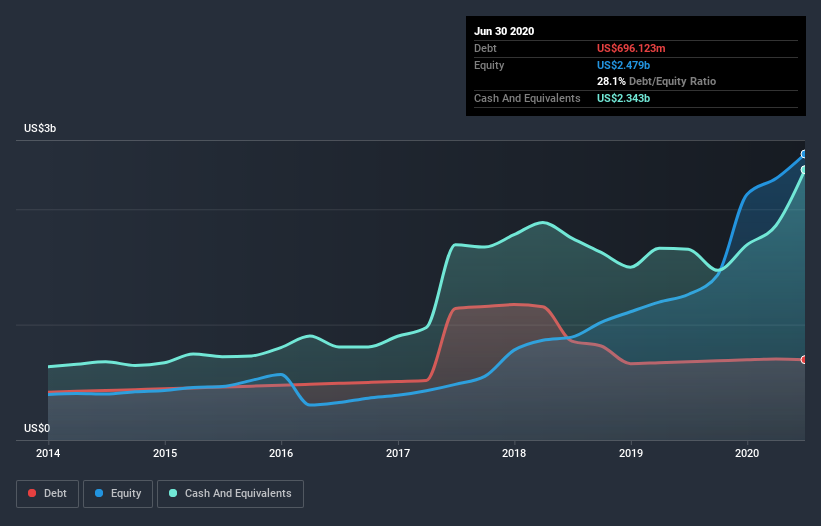ServiceNow (NYSE:NOW) Could Easily Take On More Debt

David Iben put it well when he said, 'Volatility is not a risk we care about. What we care about is avoiding the permanent loss of capital.' So it might be obvious that you need to consider debt, when you think about how risky any given stock is, because too much debt can sink a company. Importantly, ServiceNow, Inc. (NYSE:NOW) does carry debt. But is this debt a concern to shareholders?
When Is Debt A Problem?
Generally speaking, debt only becomes a real problem when a company can't easily pay it off, either by raising capital or with its own cash flow. If things get really bad, the lenders can take control of the business. While that is not too common, we often do see indebted companies permanently diluting shareholders because lenders force them to raise capital at a distressed price. Of course, the upside of debt is that it often represents cheap capital, especially when it replaces dilution in a company with the ability to reinvest at high rates of return. The first thing to do when considering how much debt a business uses is to look at its cash and debt together.
See our latest analysis for ServiceNow
What Is ServiceNow's Debt?
The chart below, which you can click on for greater detail, shows that ServiceNow had US$696.1m in debt in June 2020; about the same as the year before. But on the other hand it also has US$2.34b in cash, leading to a US$1.65b net cash position.
How Healthy Is ServiceNow's Balance Sheet?
The latest balance sheet data shows that ServiceNow had liabilities of US$2.85b due within a year, and liabilities of US$1.19b falling due after that. Offsetting these obligations, it had cash of US$2.34b as well as receivables valued at US$642.0m due within 12 months. So it has liabilities totalling US$1.06b more than its cash and near-term receivables, combined.
Having regard to ServiceNow's size, it seems that its liquid assets are well balanced with its total liabilities. So it's very unlikely that the US$97.0b company is short on cash, but still worth keeping an eye on the balance sheet. Despite its noteworthy liabilities, ServiceNow boasts net cash, so it's fair to say it does not have a heavy debt load!
It was also good to see that despite losing money on the EBIT line last year, ServiceNow turned things around in the last 12 months, delivering and EBIT of US$196m. The balance sheet is clearly the area to focus on when you are analysing debt. But it is future earnings, more than anything, that will determine ServiceNow's ability to maintain a healthy balance sheet going forward. So if you're focused on the future you can check out this free report showing analyst profit forecasts.
But our final consideration is also important, because a company cannot pay debt with paper profits; it needs cold hard cash. ServiceNow may have net cash on the balance sheet, but it is still interesting to look at how well the business converts its earnings before interest and tax (EBIT) to free cash flow, because that will influence both its need for, and its capacity to manage debt. Happily for any shareholders, ServiceNow actually produced more free cash flow than EBIT over the last year. There's nothing better than incoming cash when it comes to staying in your lenders' good graces.
Summing up
While it is always sensible to look at a company's total liabilities, it is very reassuring that ServiceNow has US$1.65b in net cash. The cherry on top was that in converted 553% of that EBIT to free cash flow, bringing in US$1.1b. So is ServiceNow's debt a risk? It doesn't seem so to us. There's no doubt that we learn most about debt from the balance sheet. But ultimately, every company can contain risks that exist outside of the balance sheet. Be aware that ServiceNow is showing 2 warning signs in our investment analysis , you should know about...
If you're interested in investing in businesses that can grow profits without the burden of debt, then check out this free list of growing businesses that have net cash on the balance sheet.
This article by Simply Wall St is general in nature. It does not constitute a recommendation to buy or sell any stock, and does not take account of your objectives, or your financial situation. We aim to bring you long-term focused analysis driven by fundamental data. Note that our analysis may not factor in the latest price-sensitive company announcements or qualitative material. Simply Wall St has no position in any stocks mentioned.
Have feedback on this article? Concerned about the content? Get in touch with us directly. Alternatively, email editorial-team@simplywallst.com.

 Yahoo Finance
Yahoo Finance 
